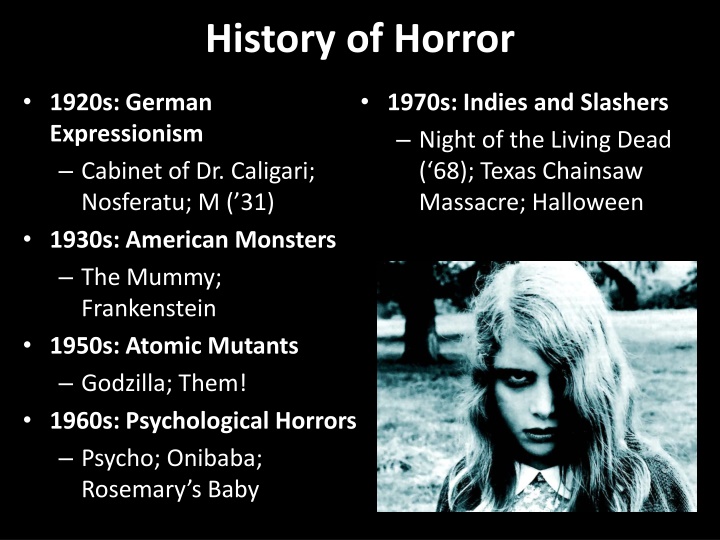
Evolution of Horror Films: From German Expressionism to New Wave Cinema
Explore the evolution of horror films from the German Expressionism era of the 1920s to the New Wave movement of the 1960s and beyond. Discover iconic movies like "Nosferatu," "Psycho," and "Peeping Tom" that pushed boundaries and influenced the cinematic landscape.
Download Presentation

Please find below an Image/Link to download the presentation.
The content on the website is provided AS IS for your information and personal use only. It may not be sold, licensed, or shared on other websites without obtaining consent from the author. If you encounter any issues during the download, it is possible that the publisher has removed the file from their server.
You are allowed to download the files provided on this website for personal or commercial use, subject to the condition that they are used lawfully. All files are the property of their respective owners.
The content on the website is provided AS IS for your information and personal use only. It may not be sold, licensed, or shared on other websites without obtaining consent from the author.
E N D
Presentation Transcript
History of Horror 1920s: German Expressionism Cabinet of Dr. Caligari; Nosferatu; M ( 31) 1930s: American Monsters The Mummy; Frankenstein 1950s: Atomic Mutants Godzilla; Them! 1960s: Psychological Horrors Psycho; Onibaba; Rosemary s Baby 1970s: Indies and Slashers Night of the Living Dead ( 68); Texas Chainsaw Massacre; Halloween
Three From 1960: Film in Transition Psycho (dir. Alfred Hitchcock) Pushed the boundaries of the Hays code Hugely successful Breathless (dir. Jean-Luc Godard) Helped inaugurate the new wave movement Youth and Aesthetic Rebellion The Magnificent Seven (dir. John Sturges) A remake of Kurosawa s Seven Samurai Globalization of cinema
Peeping Tom: Life and Afterlife 1940s and 50s: Powell and Pressburger (The Archers) build a reputation Ex. The Red Shoes (1948) 1960: Powell s Peeping Tom released to scathing reviews: The only really satisfactory way to dispose of Peeping Tom would be to shovel it up and flush it swiftly down the nearest sewer. Even then the stench would remain. 1979: Martin Scorsese champions a restoration and re-release 1990s: Criterion Collection Release
Peeping Tom: Things to Look For Mise-en-scene: How does arrangement of space contribute to the suspense and horror? What happens onscreen versus off? How is color used? Costuming? Light? How does Mark arrange his subjects? What is the film s point-of-view, and how does that shape your response? Is the film sadistic? In other words, does it take pleasure in suffering?
